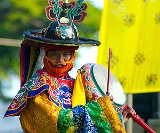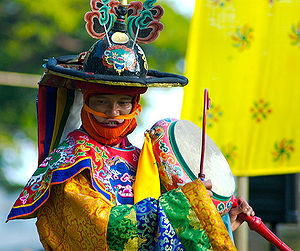
Cham Dance
Encyclopedia

Buddhism
Buddhism is a religion and philosophy encompassing a variety of traditions, beliefs and practices, largely based on teachings attributed to Siddhartha Gautama, commonly known as the Buddha . The Buddha lived and taught in the northeastern Indian subcontinent some time between the 6th and 4th...
, and is part of Buddhist festivals. The dance is accompanied by music played by monks using traditional Tibetan instruments
Musical instrument
A musical instrument is a device created or adapted for the purpose of making musical sounds. In principle, any object that produces sound can serve as a musical instrument—it is through purpose that the object becomes a musical instrument. The history of musical instruments dates back to the...
. The dances often offer moral
Moral
A moral is a message conveyed or a lesson to be learned from a story or event. The moral may be left to the hearer, reader or viewer to determine for themselves, or may be explicitly encapsulated in a maxim...
instruction relating to compassion
Karuna
Karuā is generally translated as "compassion" or "pity". It is part of the spiritual path of both Buddhism and Jainism.-Buddhism:...
for sentient beings
Sentient beings (Buddhism)
Sentient beings is a technical term in Buddhist discourse. Broadly speaking, it denotes beings with consciousness or sentience or, in some contexts, life itself. Specifically, it denotes the presence of the five aggregates, or skandhas...
and are held to bring merit
Merit (Buddhism)
Merit is a concept in Buddhism. It is that which accumulates as a result of good deeds, acts or thoughts and that carries over to later in life or to a person's next life. Such merit contributes to a person's growth towards liberation. Merit can be gained in a number of ways...
to all who perceive them.
Cham dances are considered a form of meditation
Buddhist meditation
Buddhist meditation refers to the meditative practices associated with the religion and philosophy of Buddhism.Core meditation techniques have been preserved in ancient Buddhist texts and have proliferated and diversified through teacher-student transmissions. Buddhists pursue meditation as part of...
, and an offering to the gods. The leader of the cham is typically a musician, keeping time using some percussion instrument like cymbal
Cymbal
Cymbals are a common percussion instrument. Cymbals consist of thin, normally round plates of various alloys; see cymbal making for a discussion of their manufacture. The greater majority of cymbals are of indefinite pitch, although small disc-shaped cymbals based on ancient designs sound a...
s, the one exception being Dramyin Cham
Dramyin Cham
Dramyin Cham is a form of Cham dance - a masked and costumed dance performed in Tibetan Buddhism ceremonies in Bhutan, Sikkim, Himalayan West Bengal and Tibet . They are a focal point of the Bhutanese festivals of Tsechu...
- where time is kept using dramyin
Dramyin
The dramyin or dranyen is a traditional Himalayan folk music lute with seven strings, used primarily as an accompaniment to singing in the Drukpa Buddhist culture and society in Bhutan, as well as in Tibet, Sikkim and Himalayan West Bengal. It is often used in religious festivals of Vajrayana...
.
Cham content
Chams often depict incidents from the life of PadmasambhavaPadmasambhava
Padmasambhava ; Mongolian ловон Бадмажунай, lovon Badmajunai, , Means The Lotus-Born, was a sage guru from Oddiyāna who is said to have transmitted Vajrayana Buddhism to Bhutan and Tibet and neighbouring countries in the 8th century...
, the 9th century Nyingmapa teacher and other saints.
The great debate of the Council of Lhasa
Council of Lhasa
The Council of Lhasa, also called the Council of Samye or the Great Debate, was a debate from 792 to 794 at the Samye Monastery in Tibet....
between the two principal debators or dialecticians, Mo Ho Yen and Kamalaśīla is narrated and depicted in a specific cham dance once held annually at Kum-Bum Dshamba Ling, Tibet.
Bhutan
In BhutanBhutan
Bhutan , officially the Kingdom of Bhutan, is a landlocked state in South Asia, located at the eastern end of the Himalayas and bordered to the south, east and west by the Republic of India and to the north by the People's Republic of China...
, the dances are performed during an annual religious festival
Festival
A festival or gala is an event, usually and ordinarily staged by a local community, which centers on and celebrates some unique aspect of that community and the Festival....
known as Tsechu
Tsechu
Tsechu are annual religious Bhutanese festivals held in each district or dzongkhag of Bhutan on the tenth day of a month of the lunar Tibetan calendar. The month depends on the place, but usually is around the time of October. Tsechus are religious festivals of Drukpa Buddhism...
, which is held in each district. Only monks or male members of the Royal Academy of Performing Arts
Royal Academy of Performing Arts
The Royal Academy of Performing Arts is a Bhutanese government body within the Ministry of Home and Cultural Affairs, Department of Culture, that supports the preservation of traditional Bhutanese culture. It was founded in 1954 under the initiative of the Third Druk Gyalpo Jigme Dorji Wangchuck...
are allowed to perform a cham dance in Bhutan.

